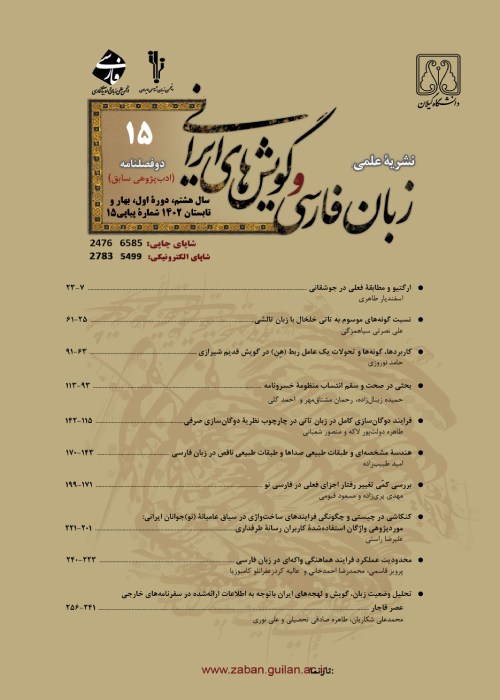The Functions of [rɒː] in Some Persian Dialects of Khorasan
In this study, the function of “rɒː” in some Persian dialects of Khorasan is sought. There are many studies of various kinds about the function of “rɒː” both in contemporary and previous periods of Persian. The reason behind it is the various position of “rɒː” as well as the changing function of it during various periods of Persian Language. However, the function of “rɒː” in Persian dialects and other Iranian languages and dialects is not well addressed yet. It seems that this grammatical function shows a different mode in Iranian languages and dialects from that of Persian Language.
This study is descriptive-analytic and the data are gathered from two sources: one from the printed works like articles and theses which are called secondary data and the other from the native speakers of the dialects which is called primary data. The source of the printed works has been cited in the text.
/rɒ:/ locates in a different position and has a different behavior comparing to the other Persian adpositions, so in different research it is identified with different names, such as case marker, adposition and direct object marker. In the traditional Persian grammars it is a marker which identifies direct object. In linguists’ works it has been paid attention to both syntactic (direct object marker) and semantic-discursive functions (as definiteness, topic or contrastive topic, specificity and presupposition marker). For example Sadeghi (1348) calls it a definiteness marker and Dabir-Moghaddam introduces it as a topic marker. Karimi (2003, 1996, 1990, 1989) attributes it a specificity marking function and Ghomeshi(1996) and Ganjavi(2007) believe that it’s a presupposition marker. Hosseini Fatemi (2013) challenges all these functions and believes that “while definiteness, specificity and presupposition capture important aspects of the meaning of /rɒ:/, none of them adequately characterize its semantics and they cannot give a unified account for all its functions”. In her opinion,” /rɒ:/ is a vacuous element which signals the presence of maximality operators higher in the structure”.
Studying the given dialects showed that “rɒː” plays four functions: the first is the same function that is found in Standard Persian that is direct object. In most dialects, this function appears both independently and in clitic form. In some dialects like “khafi” and “Delbari”, it seems to be used only in its clitic form that means its grammaticalization process is a step forward than standard Persian.
The second function is the preposition “to”. This is seen in some dialects as “Kakhki” and “Neishabouri”. This function is found in the texts of Modern Persian in its first and second periods. It is also used in these texts within some other different functions. The third function of it is to appear in some sentences with enclitic compound verbs, pronominal compound verbs or temporary composite such as “khosh amadan” (to like), “khab mandan” (to fall asleep), “dard amadan” (to hurt), etc. In these structures, the surface subject does not correspond with the verb that is always in its third singular person form.
Studying these structures in the given dialects showed that there are three forms in this respect. In some dialects like Bajestani, the verbs along with the same indexed clitic forms appear with the potential surface subject like that of standard Persian:xoš-om miyâ
like-I come-she/he
I like.
In some dialects like “Khafi”, the pronoun does not appear in clitic form, but independently:az u xoš mo namiya
from him/her like I not-come-she/he
I don’t like him/her
In some dialects like “Kakhki”, this structure is produced with “rɒː” in the absence of the same indexed pronoun with surface subject:Zahrâ-rɒː bad miya
Zahrɒː-DO marker bad come-she/he
Zahrɒː dislikes it.
The form of “Kakhki” is used in the first and second periods of modern Persian, the trace of which is abundant in the works of Gulistan of Sa’di and Tarikh-i Bayhaqi. Regarding the fact that in these works, there can be found clitic pronoun of the above structures in limited scale and contemporary Persian is qualified to produce clitic form, it can be claimed that these changes follow the Dual Acquisition Theory of Hawking.
The fourth function of “rɒː” is the not-syntactic use of this marker that is evident in fewer dialects. In other words, this sign is syntactically pointless and expletive and it seems it has only pragmatic/discourse function. This is mostly used in some dialects like “Kakhki” and “Raghei”.
Example from Kakhki Dialect: Zahrâ rɒː az rudevalok mɛtarsa (Zahra is afraid of Lizards).
This function of “rɒː” no longer exists in the contemporary Persian but it exists in ancient periods. Some instances of it were indicated by Dehkhoda in “Samak-e Ayyar. Another form of this expletive “rɒː” was in Old and middle Persian of Zoroaster that was accompanying with the preposition /az/. Such function of “rɒː” no longer exists in Khorasan’s dialects.
Today, there are not three functions out of four functions of “rɒː” in the contemporary Standard Persian and “rɒː” as a discourse marker is seen along with the non-nominative noun phrases like indirect object noun phrases or adverbial noun phrases instead of nominative ones. In this function, “rɒː” is used so frequently today.It should be indicated that holding the discourse function of “rɒː” is not a phenomenon related to the contemporary Persian, but it holds a long history. However, nowadays the distribution of “rɒː” in this function as well as its usage domain has been changed. The study of functions of “rɒː” in these dialects showed that the situation of “rɒː’ in some Persian dialects of Khorasan is like the situation of it in the texts of Modern Persian in its first and second periods and the changes of it are a step backward than the contemporary standard Persian.
- حق عضویت دریافتی صرف حمایت از نشریات عضو و نگهداری، تکمیل و توسعه مگیران میشود.
- پرداخت حق اشتراک و دانلود مقالات اجازه بازنشر آن در سایر رسانههای چاپی و دیجیتال را به کاربر نمیدهد.



